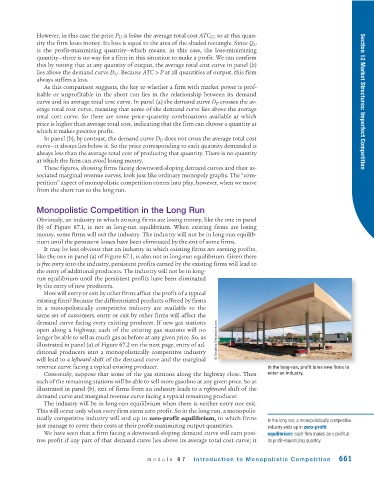Page 703 - Krugmans Economics for AP Text Book_Neat
P. 703
However, in this case the price P U is below the average total cost ATC U ; so at this quan-
tity the firm loses money. Its loss is equal to the area of the shaded rectangle. Since Q U
is the profit-maximizing quantity—which means, in this case, the loss-minimizing
quantity—there is no way for a firm in this situation to make a profit. We can confirm
this by noting that at any quantity of output, the average total cost curve in panel (b)
lies above the demand curve D U . Because ATC > P at all quantities of output, this firm
always suffers a loss.
As this comparison suggests, the key to whether a firm with market power is prof-
itable or unprofitable in the short run lies in the relationship between its demand
curve and its average total cost curve. In panel (a) the demand curve D P crosses the av- Section 12 Market Structures: Imperfect Competition
erage total cost curve, meaning that some of the demand curve lies above the average
total cost curve. So there are some price–quantity combinations available at which
price is higher than average total cost, indicating that the firm can choose a quantity at
which it makes positive profit.
In panel (b), by contrast, the demand curve D U does not cross the average total cost
curve—it always lies below it. So the price corresponding to each quantity demanded is
always less than the average total cost of producing that quantity. There is no quantity
at which the firm can avoid losing money.
These figures, showing firms facing downward-sloping demand curves and their as-
sociated marginal revenue curves, look just like ordinary monopoly graphs. The “com-
petition” aspect of monopolistic competition comes into play, however, when we move
from the short run to the long run.
Monopolistic Competition in the Long Run
Obviously, an industry in which existing firms are losing money, like the one in panel
(b) of Figure 67.1, is not in long-run equilibrium. When existing firms are losing
money, some firms will exit the industry. The industry will not be in long-run equilib-
rium until the persistent losses have been eliminated by the exit of some firms.
It may be less obvious that an industry in which existing firms are earning profits,
like the one in panel (a) of Figure 67.1, is also not in long-run equilibrium. Given there
is free entry into the industry, persistent profits earned by the existing firms will lead to
the entry of additional producers. The industry will not be in long-
run equilibrium until the persistent profits have been eliminated
by the entry of new producers.
How will entry or exit by other firms affect the profit of a typical
existing firm? Because the differentiated products offered by firms
in a monopolistically competitive industry are available to the
same set of customers, entry or exit by other firms will affect the
demand curve facing every existing producer. If new gas stations
open along a highway, each of the existing gas stations will no
longer be able to sell as much gas as before at any given price. So, as © Tondafoto/Dreamstime.com
illustrated in panel (a) of Figure 67.2 on the next page, entry of ad-
ditional producers into a monopolistically competitive industry
will lead to a leftward shift of the demand curve and the marginal
revenue curve facing a typical existing producer. In the long-run, profit lures new firms to
Conversely, suppose that some of the gas stations along the highway close. Then enter an industry.
each of the remaining stations will be able to sell more gasoline at any given price. So as
illustrated in panel (b), exit of firms from an industry leads to a rightward shift of the
demand curve and marginal revenue curve facing a typical remaining producer.
The industry will be in long-run equilibrium when there is neither entry nor exit.
This will occur only when every firm earns zero profit. So in the long run, a monopolis-
tically competitive industry will end up in zero-profit equilibrium, in which firms In the long run, a monopolistically competitive
just manage to cover their costs at their profit-maximizing output quantities. industry ends up in zero-profit
We have seen that a firm facing a downward-sloping demand curve will earn posi- equilibrium: each firm makes zero profit at
tive profit if any part of that demand curve lies above its average total cost curve; it its profit-maximizing quantity.
module 67 Introduction to Monopolistic Competition 661

